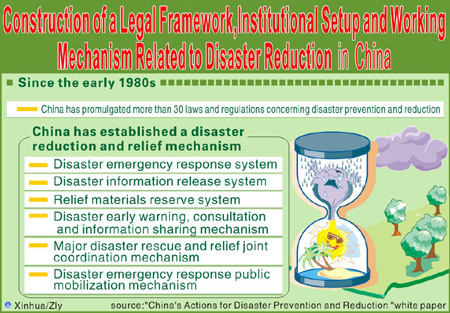China published a White Paper Monday on disaster prevention and relief efforts to mark the first anniversary of the Wenchuan earthquake, as well as the nation's first "Disaster Prevention and Reduction Day," both of which fall on May 12.
The white paper, released by the State Council Information Office, reviews government work or policies.
"China is one of the countries that experiences the most natural disasters," the report said.
With climate change, economic growth and urbanization, China faced increasing pressure on its resources and environment, it said.
The work of preventing and responding to natural disasters has become "more serious and complicated," the paper said.
Given that many kinds of wide-ranging disasters frequently hit China and caused huge losses, China's main tasks were to strengthen its ability to manage potential risks of natural disasters, to monitor and forecast natural disasters, to prevent them and conduct rescue and relief, the report said.
"Based on the lessons we learned and problems found in rescue and relief work for winter storms in south China in early 2008 and the May 12 earthquake, we have made efforts to improve the country's disaster management system," Zou Ming, director of the disaster relief department under the Ministry of Civil Affairs, told a press conference here on May 11.
The magnitude-8.0 quake, with an epicenter in Wenchuan in southwest China's Sichuan Province, left more than 87,000 people dead or missing and more than 374,640 injured.
The country is amending its state-level contingency plan for natural disaster relief and will ask local governments, rural and urban communities to make corresponding plans, he said.
A government regulation on disaster relief, now publicized for public comment, was drafted to set standard rules for disaster relief as most of the existing laws and regulations only apply to a certain type of disaster.
China also planned to increase the number of state-level storage facilities for relief materials, such as tents, blankets, medicines and rescue devices, from 10 to 24 so that it will react faster in face of a serious disaster, he added.
China has developed a disaster control and response system, which covers leadership from the State Council and central government departments as well as disaster control departments at different levels, the document said.
Since 2005, 17.54 billion yuan (2.54 billion U.S. dollars) has been invested nationwide in renewing and building 5.8 million houses for 6.5 million needy people so that their residences would be disaster proof.
In light of school building quality in the Wenchuan earthquake, China launched a three-year program in April that aims to examine every school building for safety flaws and reinforce those in earthquake-prone areas.
It will receive a subsidy of 8 billion yuan (1.16 billion dollars) from the central budget.
Sichuan provincial government announced last Wednesday that 5,335 students were dead or missing in the province, after thousands of schools collapsed in May 12 earthquake.
An amendment to the Law on Precautions Against Earthquake and Relief of Disaster, taking effect on May 1, also required school buildings to stand quakes of at least 8 magnitude.
The country is also working on a three-dimensional natural disaster monitoring system on land, sea and from space, made up of satellites, radar and ground stations, according to the document.
China attaches great importance to public participation in disaster prevention and reduction and encourages individual volunteers to take part, it said.
By the end of 2008, there were 1,531 charity foundations in China, 162 more than the previous year. The authorities also registered about 430,000 volunteer organizations, such as volunteer organization under the Chinese Communist Youth League, with an estimated 100 million members.
With an open and cooperative attitude, China took an active part in international efforts in disaster relief, including building international cooperative disaster-reduction mechanisms and providing mutual aid with other countries in major natural disasters, the document said.
After the Indian Ocean tsunami in December, 2004, China provided the largest emergency aid in its history, totaling 687.63million yuan, to the affected countries and related UN agencies. It also promptly dispatched an international rescue team and a medical team to Indonesia.
For the full text of the white paper, please visit: http://english.cri.cn/6909/2009/05/11/1781s483538.htm
(From Xinhua)






